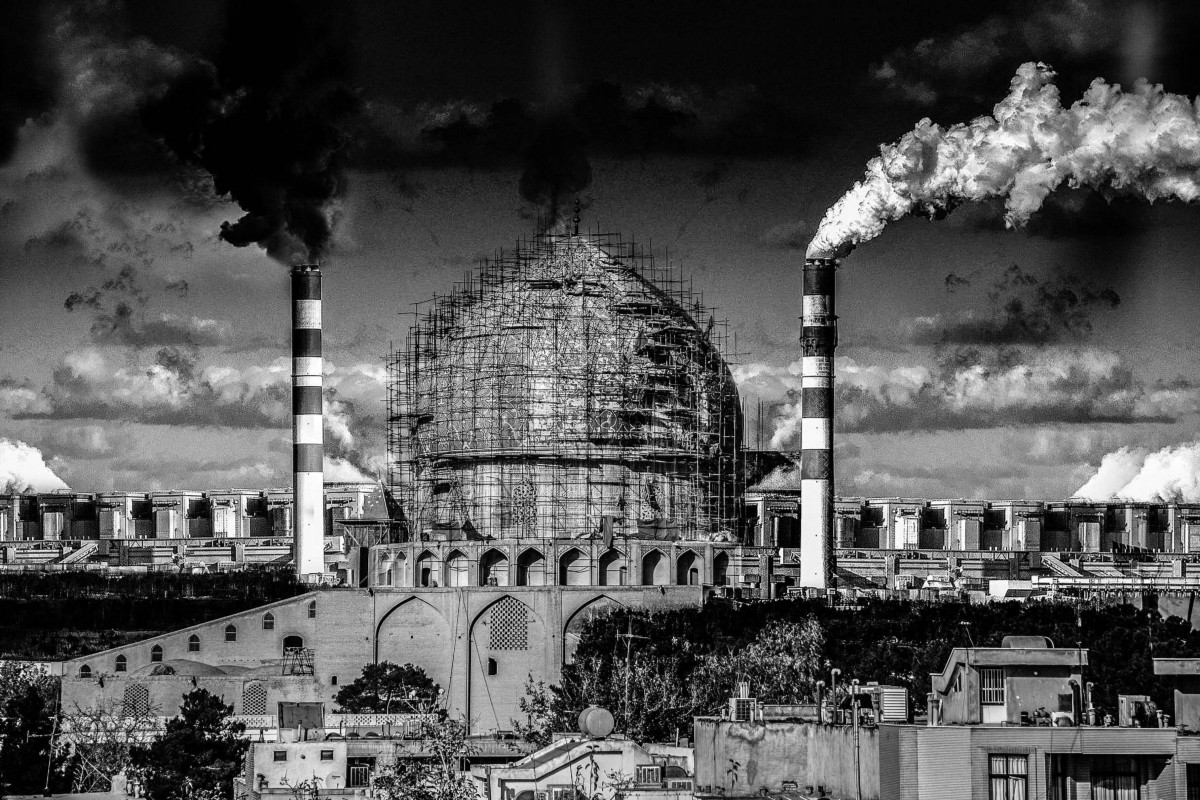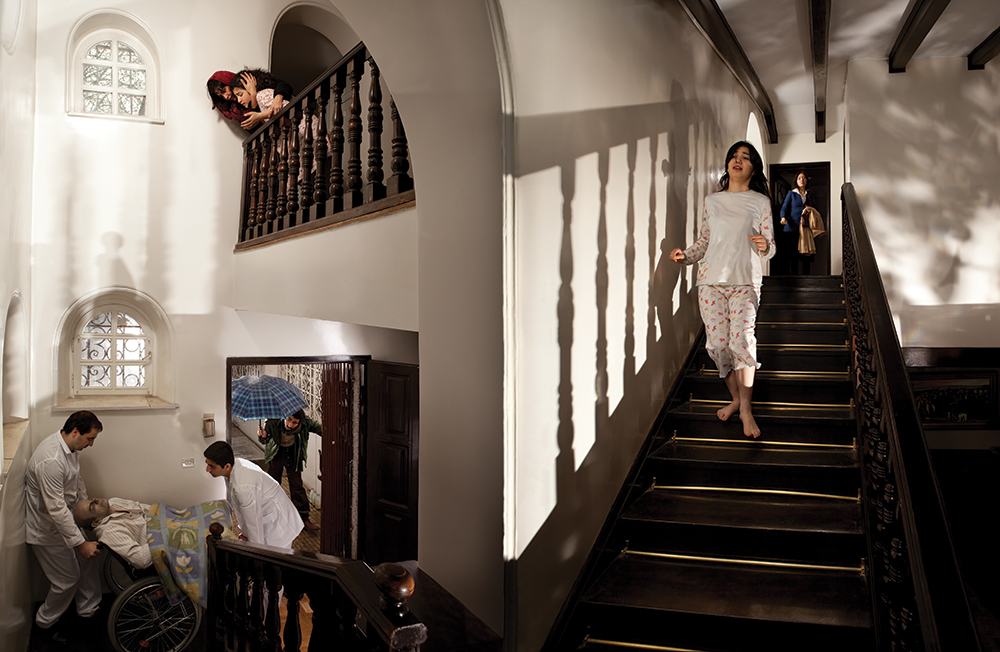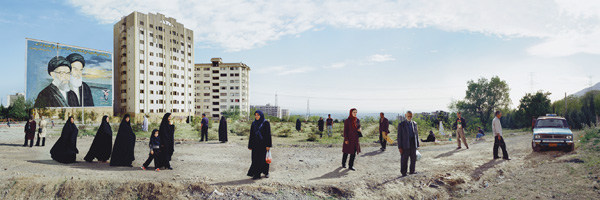Beyond realism: Iran's photographers recreate images of nation
When carrying a camera in public became risky, many Iranian photographers turned to conceptual forms of image capturing

In staged photography, characters and objects are arranged for picturesque or dramatic effect (Courtesy of Armin Amirian, from the 2015 Analogy series)
27 November 2019 10:42 UTC |
Staged photography, a genre characterised by technical, decorative and theatrical innovations, became a popular option for a growing number of photojournalists and aspiring photographers in Iran following the 2009 post-election protests.
Triggered by the disputed re-election of then President Mahmoud Ahmadinejad in June 2009, millions took to the streets in protests that led to dozens being killed and thousands arrested. Anyone with a camera became a target of a violent crackdown by authorities seeking to prevent photos of the unrest reaching the world.

According to Reporters Without Borders, in the year that followed the protests, 170 journalists, photographers and bloggers, who bore the brunt of the government crackdown, were arrested. Around 3,000 journalists lost their jobs and scores fled the country.
“People didn’t trust photographers for some time after 2009,” says Newsha Tavakolian, who at the time worked as a photographer for the New York Times before turning to staged photography in 2010. “It was not possible for half a year to do our work because of these sensitivities,” she adds, referring especially to those who worked as freelancers for foreign media.
For many who remained in Iran, staged photography, in which characters and objects are arranged for picturesque or dramatic effect, became an alternative pursuit - moving away from politically charged subjects and towards documenting social, cultural or historical issues.
This genre of photography, which gained ground in the 1980s through the works of Western artists such as Cindy Sherman and Jeff Wall, allowed them to circumvent tightening government restrictions.
“Today, the dominant modern Iranian photography is staged,” says Rozita Sharafjahan, owner of Azad Art Gallery in Tehran. “It’s very difficult to do documentary photography in Iran. It is restricted in most places, such as the streets and public places.”
Uncovering life's fragility
Babak Kazemi, now aged 35, abandoned photojournalism after becoming frustrated with covering official events, and because of the restrictions the industry faces: “We needed a permit for every single location we wanted to photograph,” he says.
Much of Kazemi’s work focusses on the lingering effects of the 1980-88 Iraq war and the devastating impact of the oil industry on the people, environment and politics of his oil producing home province of Khuzestan.

Through his photos, mostly taken by analogue camera, he tries to raise awareness and uncover life’s fragility and limitations. He captures the effects of oil pollution by tampering with images of soldiers, soaking them in petroleum that causes the prints’ gelatine to swell.
The bubbles, Kazemi says, represent “social blisters” caused by the oil industry.
In his Khorramshahr Number by Number series, Kazemi superimposes photographs of people and scenes onto pictures of rusty bullet-ridden number plates from homes destroyed in the war-ravaged city of Khorramshahr, alluding to the 75,000 displaced residents.
For his 2017 Anticipating collection, Kazemi, who produces his glass negatives with wet collodion plates, built a 50 x 50cm wooden format camera. He did this because he needed larger glass negatives in order to superimpose portraits onto traditional wooden doors.
These, he says, symbolise the anticipation for “the return of those who fled their destroyed homes and will never return”.
A storytelling tradition
For Armin Amirian, it was the freedom to create something new with his images that drew him to staged photography.
“I love digital photography and using apps to manipulate my photos,” he says. “It’s not about the superficial editing, such as photometric corrections, colours and good techniques. Digital technology allows me creativity with new experiences.”
'...every time this country had the chance to advance and flourish, various factors stunted its growth'- Armin Amirian
Amirian, 24, goes to great lengths to create a tableau with his images that evokes a centuries-old Iranian storytelling tradition, passed on by narrators over generations, such as naqqali (storytelling) and pardeh khani, or curtain reading.
The narrator would relay stories that glorified national or religious heroes by pointing to the colourful images on a canvas. “This is a valuable and obsolete tradition on which our culture is based,” says Amirian.
“My photography resembles those curtains, a kind of narrative that a person tells viewers. They’re not pictures of destroyed scenes or major events,” says Amirian.

He has used this narrative style in his nostalgia-rich A’ar series and in his new collection, Saraparde (Narration). “In the distant past, A’ar referred to stunted children who had been weaned too early. It’s basically the story of Iran,” because, he says, “just like a weaned infant, every time this country had the chance to advance and flourish, various factors stunted its growth.”
Recording tragedies
For 41-year-old Azadeh Akhlaghi, this form of creative photography was a choice. “I never wanted to do photojournalism,” she says, adding that her huge tableaus “only speak in the language of art”.
But her choice of topic is political. In her By An Eye Witness collection (2009-2012), she reconstructs selected deaths - some very gruesome - of dissidents and critics of the former Pahlavi monarchy.
She works with a large team of professional actors. Mahmoud Kalari, who has worked with famous Iranian film directors such as Abbas Kiarostami and Asghar Farhadi, is her chief photographer and the costume designer is Iraj Raminfar, who worked for years with legendary Iranian director Bahram Beyzai. Akhlaghi mainly directs the stage and even appears in some of the photos.

Akhlaghi says she wouldn’t necessarily categorise her art as staged photography, because its feature is illusory.
“What I have done is added history to it, just like the historical painting of the scene of Virgin Mary’s death” - except her choice of subject is Iran itself and specifically key, bloody events such as assassinations, murders and deaths.
Her aim is to record these tragedies since, she says, there are very few recorded photos of modern Iranian history, adding that people were even forbidden to talk about those deaths, which now only exist in their memories.
“Many of the characters in my projects don’t even have graves,” she says. “So I had to find a way to imagine it.”
'Chador art'
In a 2014 interview with the Canadian Broadcasting Corporation, Akhlaghi said she drew her inspiration from footage captured on bystanders’ cell phones showing Neda Agha Soltan being shot dead during the 2009 protests, although the killing itself isn’t featured in any of Akhlaghi’s collections.
"[Her death] made me think of all the freedom fighters who died without having the chance to have their pictures captured on camera,” Akhlaghi told CBC.
Shortly after the 2009 crackdown, a burst of art galleries sprang up - many of them just wanting to make money, says photography professor Roham Shiraz. So they looked for topics that would sell fast: “In other words, they had to produce what the outside world wanted. And of course the foreigner has a touristic view of Iran.”
'Everybody was doing chadors and it was selling very well. Then people got a bit bored of them'- British art curator Janet Rady
According to Iranian artists, what buyers - especially those in the West - look for is not always the artistic value of the photos. Instead, they tend to cater to stereotypical subjects that they believe attract westerners: photos that show women wearing the chador, child militias wearing green headbands emblazoned with religious writings or mean-looking bearded men brandishing rifles; boys and girls mingling at a party or hiking together; women working out in the gym; women, headscarves pushed back and their faces painted with layers of makeup.
Sharafjahan, the Tehran gallery owner, says she resents this "condescending" attitude of western curators: “There was this thirst to see Iranian art and say, ‘Bravo, they can also paint… look what they’ve done!'”
“Chador art,” as some Iranian artists mockingly refer to art portraying Iranian stereotypes, may still be in circulation, but it is being increasingly challenged. Of the trend of Iranian artists catering to western stereotypes Tavakolian says: “Those days are over,” adding that thanks to the internet, they know what is going on in the world.
"They critique each other, meet and discuss their work.” Anyone who errs is “ostracised by the photographers themselves,” Tavakolian says, adding that an increasing number of curators and institutions are on the look out for fresh, more authentic talent.
British art curator Janet Rady agrees. When contemporary Iranian art first became popular in London about a decade ago, “everybody was doing chadors and it was selling very well. Then people got a bit bored of them,” she says.

Still, some Iranian artists admit it can be difficult to escape the paradoxes that exist in Iran. “It’s a struggle, but it’s doable,” says Tavakolian. Even those who painstakingly try to avoid cliches sometimes use them.
It depends, they say, how they’re shown and what the artists’ intentions are.
Amirian says he avoids cliches in his work to ensure his photos are not “exploited”. “When you focus on symbols,” he says, “they become logos, commodities, not art. There are so many other dimensions to our culture."
Alluding to wider social issues
In one of her pieces, Tehran 2006, Mitra Tabrizian, a British-Iranian professor of photography, depicts a disparate crowd of people in a public space, using details to allegorically allude to wider social issues in Iran.
For example, to denote different ways in which people are “stuck” in their daily activities, she portrays a broken down taxi or a woman’s chador caught in the bush.

Inspired by the pioneering work of Tabrizian, one of 39-year-old Iranian artist Gohar Dashti's early collections, Today’s Life and War, portrays a couple defying all odds as they live in the shadow of the Iran-Iraq war that devastated their southwestern region of Iran, with tanks and armed soldiers looming in the background.
The photos include the couple driving on their honeymoon in the midst of carnage, sitting at a dinner table with a tank gun pointing at them, or watching television in a sandbagged setting.
Dashti says she has ended up almost eliminating people from her photographs, instead increasingly portraying places and objects, such as abandoned houses and uprooted plants. “To make sure that my work is seen solely for its artistic value and is not misinterpreted, people are getting smaller and smaller to the point that you hardly see them in my photos,” says Dashti.
For Dashti, the impetus for her choice of staged photography as an art form stems from her interest in historical and cultural issues. “We come from a society seeped in poetry, that speaks in layers. Staged photography in Iran is layered with ambiguity,” she says.
Although the technique came from the West, “ours has taken on a very much Eastern style”.

0 Comments:
Post a Comment
Subscribe to Post Comments [Atom]
<< Home